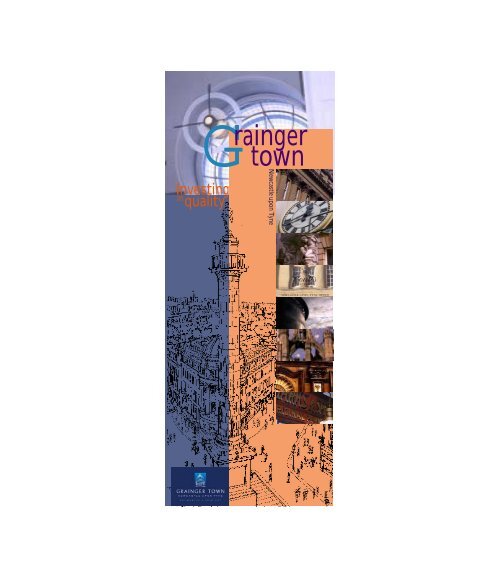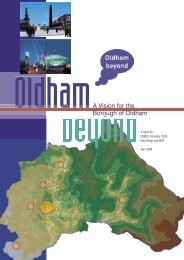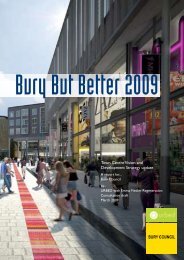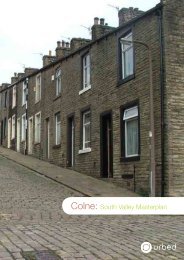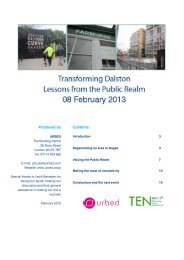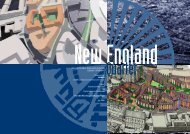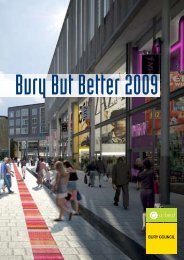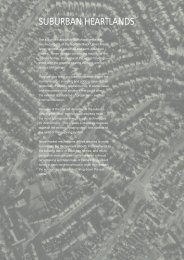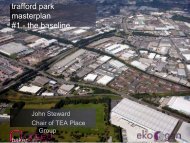Grainger Town Handbook - Urbed
Grainger Town Handbook - Urbed
Grainger Town Handbook - Urbed
Create successful ePaper yourself
Turn your PDF publications into a flip-book with our unique Google optimized e-Paper software.
<strong>Grainger</strong> town<br />
Investing<br />
in quality<br />
Newcastle upon Tyne
Foreword<br />
After the last few years, the name ‘<strong>Grainger</strong> <strong>Town</strong>’ now<br />
stands for ‘quality’ in our Northern urban environment.<br />
What visionary builder, Richard <strong>Grainger</strong>, and succeeding<br />
designers of flair and ability, have bequeathed to us, is a city<br />
centre of exceptional quality, second to none in the country.<br />
But, although most of us by now respect this quality<br />
and its undoubted value to the economy of Newcastle,<br />
there are others who do not share this recognition and<br />
understanding. Personal development interests and short<br />
term gain sometimes get in the way.<br />
This persuasive publication is aimed at these limiting<br />
interests. It urges doubters to think again and to admit the<br />
reality of the long term value of investing in quality. Telling<br />
statements are ordered and relevant<br />
evidence is marshalled to settle the sterile<br />
‘conservation versus development’<br />
argument once and for all.<br />
So let us join in partnership to<br />
retain and enhance the quality in<br />
<strong>Grainger</strong> <strong>Town</strong> because now we all<br />
know it makes good financial sense too.<br />
Councillor Tony Flynn<br />
Chairman of the <strong>Grainger</strong> <strong>Town</strong> Partnership and<br />
Leader of Newcastle City Council<br />
The <strong>Grainger</strong> <strong>Town</strong> Project<br />
1st Floor<br />
Central Exchange Buildings<br />
128 <strong>Grainger</strong> Street<br />
Newcastle upon Tyne<br />
NE1 5AF<br />
tel: 0191 261 9000<br />
fax: 0191 230 3770<br />
We welcome this timely<br />
report on Newcastle’s<br />
magnificent <strong>Grainger</strong><br />
<strong>Town</strong>. We endorse its view that<br />
historic areas of city centres can<br />
become ‘great places’ for both<br />
investors and local communities<br />
while still conserving their heritage.<br />
Some people, even some<br />
professionals, are sceptical<br />
of the value of retaining<br />
historic buildings<br />
and feel frustrated<br />
by the restrictions<br />
imposed on Listed<br />
Buildings in particular.<br />
But experience<br />
shows that with skill,<br />
creativity and persistence worthwhile<br />
solutions can be found to<br />
virtually all the problems in-<br />
Brian Brian Brian Raggett Raggett - - President of the RTPI<br />
volved. Success may take longer<br />
Simon Simon Kolesar Kolesar - - President of the RICS in a historic quarter, as it depends<br />
on promoting a mix of<br />
Sir Sir Jocelyn Jocelyn Stevens Stevens - - Chairman of English Heritage<br />
uses and raising demand<br />
Stuar Stuart Stuar t Lipton Lipton - - Chair of the Commission for throughout the area, but it is<br />
Architecture and the Built Environment achievable and well worth<br />
Richard Richard Ro Rogers Ro gers - - Chairman of the Urban Task Force achieving. The many examples,<br />
from Britain and abroad, show<br />
David David David Rock Rock - - President of the RIBA 1998/99<br />
this to be true.<br />
Nick Nick Thompson Thompson - - Prudential Portfolio Managers Newcastle contains some of<br />
the finest urban architecture in<br />
Michael Michael Michael Gwilliam Gwilliam - - Director The Civic Trust<br />
the country. The regeneration of<br />
Dr. Dr. Dr. Malcolm Malcolm Malcolm Airs Airs Airs - Chairman of IHBC<br />
endorsements<br />
<strong>Grainger</strong> <strong>Town</strong> is creating a<br />
memorable historic area in one<br />
of Europe’s re-awakening<br />
regional capitals. The public<br />
sector is making a substantial<br />
contribution. Now is the time<br />
for the private sector, led by<br />
the professionals, to be fully<br />
involved.<br />
<strong>Grainger</strong> town<br />
contents<br />
Page...<br />
Purpose of the handbook 2.<br />
<strong>Grainger</strong> <strong>Town</strong>’s significance 4.<br />
The value of quality 8.<br />
Plans for the future 18.<br />
Finding help and expertise 24.<br />
Grant schemes available 30.<br />
Point of contact 32.
Central<br />
Station<br />
<strong>Town</strong><br />
Wall<br />
Tyne Theatre<br />
& Opera House<br />
Blackfriars<br />
St. Mary’s<br />
Cathedral<br />
Northumberland Street<br />
The Castle Civic<br />
St. Nicholas Cathedral Centre<br />
Newcastle University<br />
9<br />
4<br />
10<br />
Assembly<br />
Rooms<br />
Eldon Square<br />
Shopping<br />
Centre<br />
Greenmarket<br />
grown in<br />
<strong>Grainger</strong><strong>Town</strong> Case studies referred to in this handbook<br />
1 The Union Rooms<br />
£4 million pub development 3 The Red Box<br />
Mixed-use conversion 5 Central Exchange<br />
Residential conversion 7 Former Binns Store<br />
Fashion retail development<br />
2 The Metropolitan 4 76-80 Clayton Street 6 Bank of England 8 Public Realm Works<br />
New bar/restaurant<br />
St. James’ Park<br />
Eldon Square<br />
Living over the shop<br />
New commercial space<br />
Environmental improvements<br />
The Quayside<br />
University of<br />
Northumbria<br />
9<br />
Eldon Square<br />
<strong>Grainger</strong><br />
Market<br />
Galen House<br />
New housing development<br />
1<br />
Central Station<br />
7<br />
Grey’s<br />
Monument<br />
5<br />
Theatre Royal<br />
St. Nicholas’<br />
Cathedral<br />
10 Turners<br />
purpose<br />
Building<br />
Workspace for small businesses<br />
8<br />
3<br />
handbook<br />
of the<br />
The <strong>Grainger</strong> <strong>Town</strong> Vision<br />
“<strong>Grainger</strong> <strong>Town</strong> will become a dynamic and competitive location in the heart of the City.<br />
<strong>Grainger</strong> <strong>Town</strong> will develop its role in the regional economy with a high-quality environment<br />
appropriate to a major European regional capital. Its reputation for excellence will be focused<br />
on leisure, culture and the arts, retailing, housing and entrepreneurial activities. <strong>Grainger</strong><br />
<strong>Town</strong> will become a distinctive place, a safe and attractive location to work, live and visit.”<br />
6<br />
2<br />
As one of Britain’s proudest and most distinctive<br />
cities – with over 2,000 years of history and more<br />
than 1,500 Listed buildings, and now one of Europe’s<br />
emerging regional capitals – Newcastle has been<br />
actively promoting the regeneration of its city centre for<br />
some time. The results are becoming clearly visible, not only<br />
in its modern shopping centre and along the award-winning<br />
Quayside, but also in <strong>Grainger</strong> <strong>Town</strong>, its historic but previously<br />
run-down core.<br />
This handbook has been produced by urban regeneration<br />
experts URBED to help property owners and investors<br />
and their advisers make the most of the potential of<br />
<strong>Grainger</strong> <strong>Town</strong>, and to ensure that the quality of any development<br />
matches the standards now required in the successful<br />
historic quarters of great cities. The handbook:<br />
explains why <strong>Grainger</strong> <strong>Town</strong> is of national<br />
significance<br />
reviews research into the value of quality in urban regeneration<br />
and the commercial performance of Listed<br />
buildings<br />
shows what is already happening in <strong>Grainger</strong> <strong>Town</strong><br />
(through local case studies) and its future potential<br />
(drawing on success stories from comparable cities in<br />
Europe), and<br />
explains how the <strong>Grainger</strong> <strong>Town</strong> Partnership is able to<br />
help development projects.<br />
Some people claim that conservation of a historic area and<br />
development that meets modern needs are incompatible.<br />
However, other cities have used their heritage to create<br />
memorable centres which combine economic success with<br />
the highest architectural and environmental standards. Elsewhere,<br />
developers have seen Listed buildings and historic<br />
environments as assets not liabilities. Thus the potential for<br />
building on Richard <strong>Grainger</strong>’s splendid legacy to Newcastle<br />
to create a truly great and successful city centre is immense.<br />
3
What is possible<br />
4<br />
<strong>Grainger</strong><br />
significance<br />
It comes as a surprise to many<br />
people that the great industrial city<br />
of Newcastle has one of the finest<br />
centres in Britain. Famous for its<br />
dramatic bridges over the Tyne and<br />
for being one of the world’s great<br />
party cities, Newcastle has even been<br />
voted the most popular UK city to<br />
work in. Yet its magnificent central<br />
area – <strong>Grainger</strong> <strong>Town</strong> – is less well<br />
known, even though its architecture<br />
ranks with that of Bath or<br />
Edinburgh New <strong>Town</strong>.<br />
Nash’s Classical Terraces:<br />
A good investment<br />
The great sweeping curve of<br />
Regent Street designed by John<br />
Nash, which links London’s<br />
commercial West End with the<br />
large terraced houses around<br />
Regent’s Park, may have provided<br />
an inspiration for Grey Street, but<br />
these imposing buildings fell out<br />
of fashion too. Restoration work<br />
by the Crown Estate has encouraged<br />
private investment in<br />
fashionable shops and offices, and<br />
houses that not long ago were<br />
considered not worth saving have<br />
now sold for up to £7 million.<br />
<strong>Town</strong>’s<br />
‘At two we went to<br />
Newcastle and saw<br />
the principal objects,<br />
including especially the<br />
fine church and<br />
lantern, the gem of an<br />
old castle and Grey<br />
Street - I think our<br />
best modern street’<br />
Diary of W.E.Gladstone 1862<br />
The Cloth Market early 19th century, from<br />
an engraving by Thomas Miles Richardson<br />
f <strong>Grainger</strong> <strong>Town</strong>’s exceptional architectural merit<br />
there is no doubt. Virtually all of it is included in<br />
Newcastle’s Central Conservation Area, one of the<br />
first to be designated in England. 240 of its buildings, half<br />
of all those in the area, are Listed. What is more, an astonishing<br />
30% of these are designated as Grade I or Grade II*<br />
– ‘buildings… of particularly great importance to the<br />
nation’s built heritage’. In the country as a whole, only 6% of<br />
Listed buildings fall into these higher categories.<br />
<strong>Grainger</strong> <strong>Town</strong> occupies much of the southern part of<br />
the city centre, and takes its name from a series of elegant,<br />
classical streets conceived as a whole and built by Richard<br />
<strong>Grainger</strong> between 1835 and 1842, at the end of the Georgian<br />
period. Its centrepiece, Grey Street, with a wonderful<br />
rising curve, is widely acknowledged as ‘the finest Classical<br />
street in England’. However the area also includes medieval<br />
streets like Bigg Market, the 13th O<br />
century Dominican Friary<br />
of Blackfriars and remnants of the old <strong>Town</strong> Wall, and after<br />
<strong>Grainger</strong>’s day it was extended with many fine Victorian<br />
commercial buildings. All this gives <strong>Grainger</strong> <strong>Town</strong> a great<br />
richness of character. It now covers some 90 acres right in<br />
the centre of the city, between Newcastle’s Central Station<br />
and the thriving regional shopping area of Northumberland<br />
Street and Eldon Square. It is well served too by Newcastle’s<br />
efficient Metro system, and the city’s two universities, the<br />
Castle and the regenerated Quayside, with its stylish promenade,<br />
hotels and offices, are also close by. (See map page 2.)<br />
<strong>Grainger</strong> <strong>Town</strong> was built as a commercial centre with<br />
shops below housing or offices. Although there are some<br />
truly palatial buildings, such as the Theatre Royal, the former<br />
Branch Bank of England and <strong>Grainger</strong> Market, most of the<br />
original buildings are quite small, but they are joined together<br />
to form terraces with beautifully proportioned facades. The<br />
overall character of the streets is therefore just as important<br />
as the quality of the individual buildings.<br />
5<br />
‘Grey Street is...<br />
one of the best in<br />
England’<br />
Nikolaus Pevsner,<br />
Northumberland<br />
(The Buildings of England)<br />
1957
6<br />
A Brief History<br />
What makes <strong>Grainger</strong> <strong>Town</strong><br />
exceptional is the series of<br />
classical streets developed in a<br />
period of frenetic construction<br />
between 1835 and 1842<br />
which are overlaid on the<br />
pattern of the medieval<br />
settlement that was there<br />
before.<br />
Newcastle was unusual in<br />
that up until 1830 there was a<br />
large property – Anderson<br />
Place – with extensive<br />
grounds within the city walls.<br />
This became available on the<br />
death of Major Anderson in<br />
1831, creating a unique<br />
development opportunity. A<br />
number of schemes were<br />
drawn up but only Richard<br />
<strong>Grainger</strong> had the capacity to<br />
take the project on. As one<br />
commentator remarked: ‘While<br />
others think, Mr <strong>Grainger</strong> acts’.<br />
<strong>Grainger</strong>’s idea was to link<br />
the smart residential areas to<br />
the north with the cramped<br />
trading district above the<br />
quayside. In so doing he crea-<br />
ted an entirely new commercial<br />
centre with wide, elegant<br />
streets. This was both difficult<br />
and controversial. The principal<br />
street, now Grey Street,<br />
had to follow the steep curve<br />
of the Lort Burn, but <strong>Grainger</strong><br />
turned this to great advantage<br />
in designing what is acknowledged<br />
to be one of Britain’s<br />
finest streets. Two other<br />
streets, <strong>Grainger</strong> Street and<br />
Clayton Street, provided<br />
linkages to Bigg Market and<br />
Westgate Road.<br />
However several buildings,<br />
including the old theatre and<br />
the Butcher Market, had to be<br />
demolished, and a new<br />
Theatre Royal and <strong>Grainger</strong><br />
Market were built as replacements.<br />
Other fine buildings,<br />
such as the Central Exchange,<br />
formed part of the overall<br />
plan, and the composition was<br />
completed by Grey’s Monument<br />
which was erected in<br />
1838, to commemorate Earl<br />
Grey, Prime Minister from<br />
1831 to 1834, and his role in<br />
the passing of the Great<br />
Reform Act.<br />
The map to the left shows the centre of<br />
Newcastle in 1830 prior to <strong>Grainger</strong>’s<br />
developments. The plan above, drawn just<br />
14 years later, shows <strong>Grainger</strong>’s<br />
developments in their completed form.<br />
Top:<br />
Top:<br />
An early artist’s impression of the plans<br />
for <strong>Grainger</strong> <strong>Town</strong> (never fully realised).<br />
Centre:<br />
Centre:<br />
A portrait of Richard <strong>Grainger</strong> c.1830 from<br />
Laing Art Gallery (artist unknown).<br />
What is possible<br />
Leeds Victoria Quarter:<br />
A place to be proud of<br />
Leeds has promoted its<br />
centre as a ‘24 hour city’,<br />
and changed its image with<br />
specialist shops that have<br />
made use of grand 19 th<br />
century buildings such as the<br />
Corn Exchange. A recreated<br />
arcade called The Victoria<br />
Quarter has attracted a<br />
branch of Harvey Nichols,<br />
and the superbly restored<br />
market is also highly popular.<br />
Like all historic areas <strong>Grainger</strong> <strong>Town</strong> has been through<br />
many changes. First the fashionable residents began moving<br />
out to the suburbs, and the population decline continued for<br />
most of the 20 th century. Even so <strong>Grainger</strong> <strong>Town</strong>, especially<br />
Grey Street and Mosley Street, was until recently<br />
Newcastle’s prime office location. <strong>Grainger</strong> Street was its<br />
main shopping street and Clayton Street a secondary shopping<br />
area. But since the 1970s the development of the<br />
Eldon Square shopping centre and the redevelopment of<br />
the Quayside have greatly expanded the city centre, and<br />
many of the larger shops and offices have moved out of<br />
<strong>Grainger</strong> <strong>Town</strong> to more modern premises. As space,<br />
especially on upper floors, became empty and there was<br />
increased traffic on the streets, the area began to look downat-heel.<br />
N<br />
evertheless <strong>Grainger</strong> <strong>Town</strong> remains an important<br />
part of Newcastle city centre, and it is still<br />
a distinctive place. It has survived with remarkably<br />
few modern intrusions, and its streets and buildings have an<br />
underlying quality which is comparable with the very best in<br />
Europe. It has all the potential to become a memorable and<br />
prosperous quarter at the heart of a great city – a highly<br />
desirable place to live in, to work in and to visit. Its regeneration<br />
is already seeing it start to reclaim its position as a place to<br />
be proud of, and an area worth investing in for the future.<br />
7
grown in<br />
<strong>Grainger</strong><strong>Town</strong><br />
8<br />
value<br />
the<br />
quality<br />
of<br />
The Union Rooms<br />
The former Union Club in<br />
Westgate Road, a Listed<br />
Victorian building described<br />
in Pevsner as ‘a splendid<br />
French chateau’, lay empty<br />
for over 20 years in spite of<br />
its grand staircase and<br />
impressively-sized rooms and<br />
its location close to Central<br />
Station. The 22,000 sq. ft.<br />
building has recently been<br />
renovated and converted<br />
into a pub/restaurant/wine<br />
bar, which occupies the three<br />
lower floors, by the J D<br />
Wetherspoon chain. There is<br />
also space for up to 7 flats<br />
on the top two floors.<br />
Although the original<br />
building contained much<br />
wasted space, and vandalism<br />
and dry rot had caused<br />
extensive damage, the<br />
renovation has largely<br />
followed the original design.<br />
The spacious, high-ceilinged<br />
rooms have been retained;<br />
the stone staircase and the<br />
‘The <strong>Grainger</strong> <strong>Town</strong> Project Team<br />
acted as facilitators. They oiled the<br />
wheels and helped us deal with the<br />
contentious issues…They helped a<br />
dream come true’<br />
Ian Lear, Project Architect, Lawrence Tring<br />
Architects.<br />
cast iron dome have been<br />
restored; the plasterwork,<br />
fireplaces, stained glass and<br />
other details have been<br />
replaced to match what was<br />
previously there.<br />
The total cost of the<br />
project was £4.2 million, but<br />
the result is a great success.<br />
Wetherspoons know that<br />
creating a special environment<br />
with high standards is<br />
essential in such a highly<br />
competitive business as<br />
theirs. They have several<br />
Listed buildings in their<br />
estate.<br />
Only a small number of cities still retain<br />
their historic cores intact and Newcastle is<br />
one of them. Few places can boast of<br />
such a fine ensemble of streets and buildings right<br />
in their centres, and those that do now look after<br />
them with great care. Not only are they to be<br />
admired in their own right, but they are irreplaceable<br />
and, given the pressures on modern cities,<br />
unrepeatable. Above all they have the potential<br />
for creating a special atmosphere, a memorable<br />
sense of place, that can be very valuable.<br />
It is ironic that over the years the historic areas<br />
of many cities have been destroyed, often in the<br />
name of progress, and their buildings replaced<br />
with utilitarian designs that have not stood the test<br />
of time. Only with hindsight can it be seen what<br />
a mistake was often made. In London, for<br />
example, there were serious plans after the war to<br />
demolish the Nash terraces that surround Regent’s<br />
Park. Now they are among the most sought after<br />
and most expensive houses in the capital. Other<br />
areas such as Edinburgh’s Old <strong>Town</strong>, Dublin’s<br />
Temple Bar and London’s Covent Garden have<br />
been threatened too, but all have survived and<br />
become world-famous attractions.<br />
Historic areas in city centres are therefore rare,<br />
and those that do remain often enjoy great<br />
financial success, provided that sympathetic uses<br />
are found for their buildings and that the area as a<br />
whole, including its public spaces, is properly<br />
managed. While not suitable for every type of<br />
use, historic areas and the special atmosphere that<br />
they create are especially attractive for certain<br />
activities, such as tourism,<br />
housing, entertainment,<br />
creative industries<br />
and specialty<br />
shopping.<br />
9
10<br />
grown in<br />
<strong>Grainger</strong><strong>Town</strong><br />
The Metropolitan<br />
The conversion of the ground<br />
floor of 35 Grey Street into a<br />
fashionable bar and eating<br />
place shows just what can be<br />
done with the interior of a<br />
Grade II* building. The<br />
architects, Provin and Makin,<br />
have retained many of the<br />
original features but inserted a<br />
lightweight mezzanine floor to<br />
create a highly contemporary<br />
space with room for up to<br />
170 diners.<br />
The building was originally<br />
designed to house two banks.<br />
Its new lease of life illustrates<br />
both the flexibility of many<br />
historic buildings and the<br />
growing market for stylish<br />
eating and drinking in the<br />
area. The Metropolitan’s<br />
owners are now looking to<br />
expand elsewhere.<br />
‘The restoration of derelict buildings<br />
to enable contemporary economic uses<br />
sends out powerful signals to other<br />
property owners and potential<br />
investors in an area, which can<br />
spark a virtuous cycle of improvement’<br />
The Heritage Dividend, English Heritage, 1999.<br />
What is possible<br />
Dublin, Temple Bar:<br />
From liability to asset<br />
At one time Georgian buildings<br />
were seen as an unwelcome<br />
hangover from British<br />
rule, but they now help to<br />
make Dublin one of the most<br />
successful tourist destinations<br />
in Europe. Temple Bar, right in<br />
the centre of the city, which<br />
was to have been demolished<br />
to make way for a new bus<br />
station, is now one of the<br />
leading attractions. Through a<br />
mixture of public and private<br />
investment, together with<br />
energetic marketing, it has<br />
been turned into a thriving<br />
cultural quarter and alternative<br />
shopping area, with many<br />
bars, hotels and restaurants.<br />
As well as attracting large<br />
numbers of visitors, Temple<br />
Bar is also becoming a<br />
popular place to live. What<br />
was once a blighted area is now<br />
a recognised economic asset for<br />
the city.<br />
However all areas go through bad periods as well as<br />
good, through decline as well as renaissance.<br />
Historic areas can take a long time to adapt to<br />
new roles, and the process needs careful assistance. What is<br />
essential is to retain and build up the special character of<br />
the area as a whole, and to bring life and vitality back to the<br />
streets.<br />
Economic regeneration and the restoration of historic<br />
buildings need to go hand in hand, for the best way to<br />
preserve a fine building is to find the right use for it. This<br />
requires creative, flexible thinking, not necessarily standard<br />
solutions. Interim uses may need to be encouraged to<br />
create demand and to prevent buildings, or significant parts<br />
of them, deteriorating by being left empty for long periods.<br />
However, there is now no shortage of examples to<br />
draw inspiration from – many of which have succeeded in<br />
far less attractive areas than <strong>Grainger</strong> <strong>Town</strong>.<br />
11
grown in<br />
<strong>Grainger</strong><strong>Town</strong><br />
What is possible<br />
12<br />
The Red Box<br />
Newcastle’s former Post<br />
Office, an imposing Grade II<br />
Listed building in <strong>Grainger</strong><br />
<strong>Town</strong> with over 100,000<br />
sq. ft. of space on 3 floors,<br />
which was empty for 5 years,<br />
is now undergoing an imaginative<br />
conversion to a range<br />
of uses. These include offices,<br />
2 restaurants, 12 flats, a<br />
gallery and flexible space that<br />
may be used for artists<br />
studios. The principal architectural<br />
features of the building<br />
have been retained and a<br />
new roof garden created.<br />
The flats are on the market<br />
for between £140,000 and<br />
£380,000, reflecting the<br />
growing interest in ‘city<br />
living’ in Newcastle.<br />
The scheme was devised<br />
by local architect, Alan J.<br />
Smith, who saw that, with<br />
care and creativity, different<br />
uses could be fitted into the<br />
existing space. It received<br />
£1.7 million in funding from<br />
English Partnerships through<br />
One NorthEast, the Regional<br />
Development Agency and<br />
member of the <strong>Grainger</strong><br />
<strong>Town</strong> Partnership.<br />
Edinburgh Old <strong>Town</strong>: Regeneration through heritage<br />
The medieval part of Edinburgh<br />
was in such a poor<br />
state that, up until the 1970s,<br />
wholesale redevelopment<br />
seemed the only answer.<br />
However a growing realisation<br />
of the value of heritage and<br />
the importance of tourism led<br />
to a strategy to regenerate<br />
the area. Now with more<br />
visitor attractions, a greatly<br />
improved public realm, a<br />
population that has doubled,<br />
and the new Scottish<br />
Parliament, the Old <strong>Town</strong><br />
has achieved World<br />
Heritage Site status and is<br />
attracting significant<br />
amounts of private<br />
investment.<br />
As part of the overall process of regenerating<br />
Newcastle city centre, <strong>Grainger</strong> <strong>Town</strong> now<br />
has its own Project Team to help guide<br />
its regeneration. They understand the special<br />
problems of historic areas and Listed buildings<br />
Some buildings, particularly along Grey Street,<br />
Mosley Street and Collingwood Street, do<br />
provide space for large institutional users, but the<br />
majority are much more suitable for the wide<br />
mix of small-scale uses – small offices, specialist<br />
shops, restaurants, cafes, flats or houses above<br />
shops – which are now found in many successful<br />
city centres. Each of these has its own special<br />
factors for success. Some buildings just require<br />
upgrading; others may need conversion to ‘new’<br />
uses, but often these could be remarkably similar<br />
to what they were originally built for.<br />
The <strong>Grainger</strong> <strong>Town</strong> Project Team can provide<br />
information and a wide range of specialist<br />
advice (see pages 25-29.) Financial assistance is<br />
also available and has been tailored to suit the<br />
particular problems that need to be overcome<br />
(See page 31.) Often, however, the biggest<br />
change required is in the development approach<br />
that needs to be taken. In historic areas it is the<br />
entrepreneurial developers, and those who<br />
understand the long term value of quality and<br />
distinctiveness, who usually lead the way, as many<br />
of the examples in this handbook illustrate.<br />
In most cases doing things well costs little<br />
more than doing them badly, but converting and<br />
maintaining a Listed building does require more<br />
care and attention to detail than an ordinary one,<br />
13
What is possible<br />
14<br />
London, Covent Garden:<br />
A magnet for visitors<br />
After the old fruit and<br />
vegetable market moved out<br />
of Covent Garden in the<br />
1970s, the cheap empty<br />
space was taken over by<br />
small businesses and independent<br />
shops. These<br />
attracted growing numbers of<br />
visitors and helped provide<br />
customers for new galleries,<br />
wine bars and restaurants.<br />
Entertainers started performing<br />
in front of St. Paul’s<br />
Church. Temporary community<br />
gardens were created on<br />
Corner of Clayton Street and<br />
Westgate Road showing the<br />
contrast between <strong>Grainger</strong>’s<br />
architecture and the<br />
Victorian exubrance<br />
of the corner<br />
buildings<br />
development sites. Coutts<br />
Bank moved into new offices<br />
behind a Georgian facade,<br />
and new investment was<br />
drawn in as the area began<br />
to develop a lively character<br />
of its own.<br />
While, more recently,<br />
established retail chains have<br />
begun to move in, the area<br />
still retains a distinctive<br />
vitality that makes it a magnet<br />
for visitors from both<br />
home and abroad. The narket<br />
buildings remain a focus of<br />
activity and the local property<br />
market is buoyant.<br />
grown in<br />
<strong>Grainger</strong><strong>Town</strong><br />
and can be more expensive. Furthermore returns can be<br />
lower, particularly for offices, where older buildings often<br />
contain more unlettable space than modern ones, or lack<br />
facilities that some tenants require, such as car parking,<br />
disabled access or air conditioning. However, since a Listed<br />
building cannot normally be demolished and the site<br />
redeveloped, the best return will usually come from finding<br />
a use that fits the building well.<br />
I<br />
t is widely believed in the property market that Listed<br />
commercial buildings perform less well financially than<br />
unlisted ones, and they remain unpopular with institutional<br />
investors. Research by Cambridge University 1<br />
provides some support for this, concluding that there is a<br />
one-time loss of value at the time of listing, although this is<br />
less marked in Conservation Areas. Uncertainty about<br />
what alterations might be permitted and potential delays in<br />
obtaining permissions may also lower values. However,<br />
studies by the Investment Property Databank 2 show that<br />
over a longer period (1980-1995) the Listed office buildings<br />
in their database outperformed unlisted buildings in<br />
terms of their total annual return, although over shorter<br />
periods this was not necessarily so. This study also excluded<br />
the effect of maintenance costs which are usually<br />
borne by the occupier not the owner.<br />
Further research by the University of Reading and DTZ<br />
Debenham Thorpe on The Value of Conservation? 3 concludes<br />
that the economic benefits of conservation are felt<br />
throughout a wider area. The repair of Listed buildings<br />
tends to add value to adjoining properties. Repairs and<br />
improvements to conservation areas attract more people<br />
to live and do business there. Furthermore well maintained<br />
76-80 Clayton Street<br />
Flats fit particularly well into<br />
the upper floors of <strong>Grainger</strong><br />
<strong>Town</strong> because that is what<br />
many of the buildings were<br />
originally designed for. The<br />
scheme for 76-80 Clayton<br />
Street is a good example.<br />
The vacant space above<br />
ground floor shops in three<br />
Grade II Listed buildings has<br />
been converted into 12 flats<br />
by Home Housing Association.<br />
The flats are served by a<br />
separate entrance at the rear<br />
which gives access to a first<br />
floor roof-terrace. They are<br />
let at market rent (around<br />
£350 per month).<br />
Care has been taken to<br />
retain as much of the original<br />
buildings as possible.<br />
Loadbearing walls have been<br />
retained along with staircases,<br />
windows and, where<br />
possible, doors. The overall<br />
cost was approximately<br />
£54,000 per unit, but grants<br />
were obtained from three<br />
public sector sources.<br />
Obtaining all the necessary<br />
permissions and consents<br />
took time, but the <strong>Grainger</strong><br />
<strong>Town</strong> Project Team helped<br />
smooth the way. The flats are<br />
now fully let to a variety of<br />
tenants, including professionals,<br />
overseas students and<br />
local business people.<br />
15
16<br />
What is possible<br />
grown in<br />
<strong>Grainger</strong><strong>Town</strong><br />
Glasgow, Merchant City<br />
The importance of entrepreneurial developers<br />
The imaginative marketing<br />
campaign of ‘Glasgow’s Miles<br />
Better’ is credited with<br />
changing the city’s image, and<br />
it has won a number of<br />
European awards and<br />
distinctions. However some<br />
Central Exchange<br />
Buildings<br />
Central Exchange Buildings<br />
at the very heart of Newcastle<br />
right next to Grey’s<br />
Monument originally contained<br />
a magnificent hall,<br />
which Richard <strong>Grainger</strong><br />
intended to be a Corn<br />
Exchange. Instead it became<br />
a successful newsroom, art<br />
gallery and meeting place,<br />
but after a disastrous fire in<br />
1901 it was converted into a<br />
tiled arcade with offices<br />
above.<br />
However because of its<br />
many changes in level, it was<br />
never ideal for offices and the<br />
top two floors have remained<br />
empty for 5 years. Miller<br />
Homes is now converting this<br />
of the success is also due to<br />
entrepreneurial developers<br />
who renovated old buildings<br />
for housing and other uses,<br />
such as hotels and cafes, with<br />
memorable names like<br />
Babbity Bowster.<br />
space into 14 maisonettes<br />
along with managed workspace<br />
above part of the<br />
arcade. The scheme is the<br />
first to attract a major private<br />
housebuilder into the area<br />
and provides a long-term<br />
solution for an important<br />
building.<br />
What is possible<br />
historic areas encourage visitors, bringing money into the area<br />
and so increasing values. This view is also strongly supported<br />
by English Partnerships and English Heritage.<br />
Thus while individual commercial buildings or sites may<br />
suffer a short-term loss in value when they are listed,<br />
that loss can be recouped over the longer term if they<br />
form part of an area whose special character can be developed<br />
and exploited. Experience shows that the restoration<br />
of a historic area in a central location raises its appeal and<br />
liveliness, and leads to increasing values over time. In<br />
<strong>Grainger</strong> <strong>Town</strong>, everyone can benefit from the special legacy<br />
of the past, which makes the area unique and potentially<br />
valuable. But this extra value will only be achieved if standards<br />
are raised in the whole area.<br />
Everyone, particularly property owners and occupiers<br />
must play their part. The public sector is making a major<br />
contribution. It is investing over £40 million in the area (with<br />
£25 million coming from English Partnerships, £11 million<br />
from the Single Regeneration Budget £2 million from Newcastle<br />
City Council and £1.75 million from English Heritage<br />
and £250,000 from Tyneside Training and Enterprise Council).<br />
It is upgrading the public spaces and the overall environment,<br />
and it is making available expertise and support to help<br />
property owners and occupiers take advantage of the opportunities<br />
that the regeneration of <strong>Grainger</strong> <strong>Town</strong> now brings.<br />
‘People are drawn to attractive<br />
sustainable environments as<br />
places to invest and as places to<br />
live and work… A high quality<br />
environment makes good<br />
business sense. It will create<br />
value and attract investment’<br />
Space for Growth, English Partnerships, 1999.<br />
Bilbao: restoring the heart of the city<br />
Once known as a decaying steel<br />
town with huge redundant<br />
docks, Bilbao has recently<br />
reasserted its position as the<br />
leading city of the Basque<br />
Country. Regeneration started<br />
with the restoration of the Old<br />
<strong>Town</strong>’s historic shopping streets,<br />
and has continued with a<br />
stylishly designed metro system<br />
and the Guggenheim Museum,<br />
which has put it on a world<br />
map. It is a place to be proud of<br />
once more.<br />
17<br />
The view up Clayton Street, virtually all of which was developed by <strong>Grainger</strong><br />
1. K. Scanlon et al, The Listing of Buildings: Its Effect on<br />
Value. English Heritage, The Department of National<br />
Heritage and Royal Institution of Chartered Surveyors,<br />
1994.<br />
2. Investment Property Databank, The investment<br />
performance of listed buildings. Royal Institution of<br />
Chartered Surveyors and English Heritage, 1993, up-dated<br />
1994, 1995, and 1996.<br />
3. G. Allison et al, The Value of Conservation? Department<br />
of National Heritage, English Heritage and Royal<br />
Institution of Chartered Surveyors, 1996.
18<br />
grown in<br />
<strong>Grainger</strong><strong>Town</strong><br />
future<br />
The Former Bank<br />
of England<br />
The former Bank of England<br />
building, described in<br />
Pevsner as ‘a grand palazzo’,<br />
is the most imposing building<br />
on the west side of Grey<br />
Street. It is Grade II* Listed<br />
and has a spectacular row of<br />
Corinthian columns in its<br />
facade.<br />
The Bank moved out in<br />
1971 to smaller premises<br />
nearby. The building continued<br />
to be partially occupied<br />
until it was bought in 1996<br />
by Thomas Chu, a local<br />
entrepreneurial developer<br />
who wished to make it a<br />
landmark once again. It was<br />
in comparatively good<br />
condition, but needed<br />
refurbishment to suit the<br />
needs of different tenants.<br />
The ground floor has become<br />
a stylish brasserie. (See<br />
page 10.) The upper floors<br />
St John’s Church on the corner of<br />
Westgate Road and <strong>Grainger</strong> Street - a<br />
reminder of the areas Medieval history<br />
plans<br />
for the<br />
are now occupied by Coutts<br />
Bank, Knight Frank property<br />
consultants and a recruitment<br />
agency. Thomas Chu’s<br />
own offices are on the top<br />
floor in converted roof space.<br />
The project took almost<br />
two years to complete, and<br />
required constant liaison with<br />
the <strong>Grainger</strong> <strong>Town</strong> Project<br />
Team, the City Council and<br />
English Heritage. However it<br />
is now considered a resounding<br />
success. All the occupants<br />
are delighted to be in<br />
such a prestigious building in<br />
a splendid location. What is<br />
more Thomas Chu is already<br />
engaged in restoring other<br />
Listed buildings in <strong>Grainger</strong><br />
<strong>Town</strong>.<br />
‘I am proud to have this landmark<br />
building in my portfolio. Restoring it<br />
has at times been a long and difficult<br />
process, but now that it is complete, it<br />
has all been worthwhile’<br />
Thomas Chu, Owner<br />
What is possible<br />
Manchester, Whitworth<br />
Street Corridor:<br />
A desirable place to live<br />
Several thousand of apartments<br />
have been created in<br />
what were previously old<br />
warehouses to make a<br />
popular new residential<br />
quarter in the heart of<br />
Manchester. Initial projects<br />
were carried out by housing<br />
associations and they were<br />
followed by volume house<br />
builders. However, it is local<br />
specialist developers that have<br />
had the greatest success<br />
through their stylish designs,<br />
imaginative marketing efforts<br />
and attention to detail.<br />
19<br />
Now that the Quayside has been regenerated with<br />
such success, the next stage in bringing Newcastle<br />
city centre up to the standard of a major European<br />
regional capital is to focus on <strong>Grainger</strong> <strong>Town</strong>. The<br />
<strong>Grainger</strong> <strong>Town</strong> Partnership has been established to channel<br />
the public sector partners’ contributions into the area and<br />
to take the lead in implementing the agreed strategy for the<br />
area.<br />
The main elements of the strategy for <strong>Grainger</strong> <strong>Town</strong>,<br />
up to 2003, are:<br />
Extending the retail core south of the main shopping<br />
area<br />
Creating residential units above shops in <strong>Grainger</strong> Street<br />
and Clayton Street<br />
Strengthening the office core around Grey Street,<br />
Mosley Street and Collingwood Street<br />
Introducing corridors of leisure activities<br />
Upgrading the quality of public spaces and the<br />
environment.<br />
Improving accessibility and substantially reducing<br />
through traffic.
20 21<br />
grown in<br />
<strong>Grainger</strong><strong>Town</strong><br />
What is possible<br />
Former Binns Store<br />
Just as the closure in 1995 of<br />
Binns department store on<br />
the corner of Market Street<br />
and <strong>Grainger</strong> Street was a<br />
huge blow to <strong>Grainger</strong> <strong>Town</strong>,<br />
so its refurbishment for<br />
fashion outlets is a potent<br />
sign of recovery. The £10<br />
million first phase of the<br />
development by Commercial<br />
Development Projects Ltd.<br />
has created 60,000 sq. ft. of<br />
retailing. This was completed<br />
in March 1999 and has been<br />
let to Oasis, Karen Millen,<br />
Jigsaw and Envy. Phase Two is<br />
planned for completion in<br />
2000 and will include further<br />
retail units in <strong>Grainger</strong> Street<br />
Prague:<br />
A delightful place to stroll in<br />
Following UNESCO’s designation<br />
of the historic core of<br />
Prague as a World Heritage<br />
site, the municipality started<br />
restoring the pavements with<br />
patterned sets. Pedestrians<br />
now have priority, and there<br />
is excellent public transport,<br />
making it a wonderful city to<br />
stroll around. Many of the<br />
buildings and public spaces<br />
have also been restored, and<br />
a series of festivals keeps the<br />
centre popular with tourists<br />
and local people all year<br />
round. A large amount of<br />
foreign investment – attracted<br />
in part by the<br />
unspoiled heritage – has now<br />
started to flow into the<br />
‘Golden City’.<br />
as well as three restaurants<br />
on Bigg Market.<br />
Over the years the<br />
interior had been greatly<br />
altered since it was originally<br />
built. The new scheme has<br />
inserted modern retailing<br />
space behind the Grade II<br />
Listed facades. It illustrates<br />
that, with imagination and<br />
skill, the needs of contemporary<br />
users can be met while<br />
still respecting the quality of<br />
the existing buildings and<br />
townscape – thus achieving<br />
the best of both worlds.<br />
‘What we are looking at<br />
is the Bond Street of<br />
Newcastle.’<br />
James Marshall, developer<br />
Several flagship schemes are already transforming the area:<br />
The former Bank of England building and the Metropolitan<br />
(See pages 10 and 18)<br />
The former Binns store (See opposite)<br />
The Red Box scheme in the old Post Office (See page 12)<br />
Repaving the area around Grey’s Monument (See page 22)<br />
The International Centre for Life (just outside the area).<br />
Particular emphasis is now being put on:<br />
Upgrading office space, especially for small and medium-sized<br />
firms<br />
Encouraging ‘city centre living’ and bringing upper<br />
floors back into use through Living Over The Shop<br />
schemes<br />
Improving the environment to a high quality<br />
Resolving car parking difficulties<br />
Repairing run-down buildings, including shopfront<br />
improvements<br />
Providing tailor-made assistance and grants to encourage<br />
private sector investment.<br />
Careful shopfront design can<br />
create a contemporary feel<br />
while respecting and<br />
indeed enhancing the<br />
original building<br />
The International Centre for Life<br />
on the edge of <strong>Grainger</strong> <strong>Town</strong><br />
designed by Terry Farrell
22<br />
grown in<br />
<strong>Grainger</strong><strong>Town</strong><br />
What is possible<br />
Improving The<br />
Public Realm<br />
A public realm strategy for<br />
<strong>Grainger</strong> <strong>Town</strong> was prepared<br />
in 1998 by landscape<br />
architects Gillespies. This<br />
called for ‘improved links’,<br />
especially pedestrian routes,<br />
both within <strong>Grainger</strong> <strong>Town</strong><br />
and with other parts of the<br />
city, and ‘improved key<br />
streets and spaces’. Upgrading<br />
the area around Grey’s<br />
Monument (‘arguably the<br />
most important public open<br />
space in Newcastle’) was<br />
recommended as an immediate<br />
demonstration project.<br />
Detailed designs were<br />
Edinburgh New <strong>Town</strong>: An attractive identity<br />
Built at the end of the 18th<br />
century as a residential area,<br />
the New <strong>Town</strong> quickly<br />
became Edinburgh’s leading<br />
commercial quarter.<br />
undertaken by the City<br />
Council’s Engineering<br />
Services in conjunction with<br />
Gillespies, and the first phase<br />
is now complete. The aim is<br />
to create a high quality<br />
pedestrian-priority precinct<br />
that encourages appreciation<br />
of the surrounding architecture,<br />
makes walking a pleasure,<br />
improves existing linkages<br />
and helps promote<br />
social and civic activity. This<br />
is a first step in bringing the<br />
quality of the public realm in<br />
<strong>Grainger</strong> <strong>Town</strong> up to the<br />
standards found in Europe –<br />
where it has long been<br />
recognised that streets are<br />
the ‘living places’ of cities.<br />
Although some of the larger<br />
legal and financial firms have<br />
recently moved out to<br />
modern office buildings,<br />
many of the smaller firms still<br />
prefer the distinctive identity<br />
of the Georgian buildings<br />
and their elegant rooms.<br />
What is possible<br />
Gothenburg: A change of attitude<br />
Once Sweden’s great shipbuilding<br />
city, now better<br />
known as the headquarters of<br />
Volvo, Gothenburg has both<br />
broadened its attractions for<br />
business visitors and encouraged<br />
people to live in its<br />
centre once more. This has<br />
gone beyond just a focus on<br />
buildings. In a country<br />
which until recently frowned<br />
on drinking, the city now<br />
provides splendid pavement<br />
cafes on streets that are kept<br />
meticulously clean and cared<br />
for, making it much more<br />
pleasant to visit.<br />
This is a strategy that will benefit both Newcastle as a<br />
whole and individuals who invest, live or do business in the<br />
area. Its aim is to make the most of <strong>Grainger</strong> <strong>Town</strong>’s<br />
magnificent buildings and streets – medieval, classical,<br />
Victorian and modern – to create a lively and distinctive<br />
quarter of the city that people will feel proud of and be<br />
attracted to. This in turn requires that the improvements<br />
that are made both respect the exceptional architectural<br />
quality of the area, and provide facilities which are suitable<br />
for a lively mix of present day activities.<br />
T<br />
hese two aspects must be carefully balanced. New<br />
investment is required and imaginative projects will<br />
always be welcome. But while good quality modern<br />
design can enhance a historic area, all new development<br />
must be judged within the context of its surroundings and<br />
its effect on the area as a whole.<br />
Making the most of <strong>Grainger</strong> <strong>Town</strong> is, therefore, a<br />
joint enterprise. While the public sector can take the lead,<br />
private investors and existing property owners must also<br />
play their parts. <strong>Grainger</strong> <strong>Town</strong>, as one of the least known<br />
areas of great quality in a city centre, represents an outstanding<br />
opportunity for investment, but its full potential<br />
can only be achieved by working together to ensure that its<br />
special character is retained and enhanced.<br />
23
24<br />
What is possible<br />
Bath: A thriving inheritance<br />
Founded by the Romans,<br />
Bath was relaunched as a<br />
fashionable spa in the 18 th<br />
century, and contains a<br />
wealth of Georgian buildings.<br />
Despite being later eclipsed<br />
by seaside resorts and<br />
suffering extensive war-time<br />
bombing, the city centre has<br />
carefully retained and<br />
enhanced its elegant character.<br />
It now has many historic<br />
buildings open to the public<br />
and draws huge numbers of<br />
visitors from all over the<br />
world. It is also a thriving<br />
shopping centre and very<br />
popular place to live.<br />
finding<br />
expertise<br />
help and<br />
The main staircase<br />
of the newly refurbished<br />
Union Rooms<br />
The <strong>Grainger</strong> <strong>Town</strong> Project Team has a staff of 14<br />
professionals, based at Central Exchange Buildings in<br />
<strong>Grainger</strong> Street, who can provide advice and assistance<br />
on all aspects of the regeneration of <strong>Grainger</strong> <strong>Town</strong>,<br />
including how to deal with the problems and complexities<br />
of historic buildings. The Project Team is in close contact<br />
with the other agencies that are working in partnership to<br />
improve Newcastle city centre, including:<br />
Newcastle City Council<br />
One Northeast (the Regional Development Agency<br />
which has taken over English Partnerships’ local<br />
responsibilities)<br />
English Heritage<br />
Tyneside Training and Enterprise Council<br />
It is therefore the natural first port of call for all matters<br />
concerning investment or doing business in <strong>Grainger</strong><br />
<strong>Town</strong>. The contact address is given on the back cover of<br />
this handbook.<br />
25<br />
An important part of<br />
<strong>Grainger</strong> <strong>Town</strong>’s character<br />
is the contrast between<br />
the grand classical<br />
streets and narrow<br />
medieval alleys
What is possible 26<br />
Helsinki: Encouraging small<br />
enterprise<br />
Helsinki is a comparatively<br />
isolated city that knows the<br />
value of enterprise and<br />
communication. Finland’s<br />
mountainous terrain and<br />
scattered towns helped Nokia<br />
become the pioneer of the<br />
mobile phone industry.<br />
Continued innovation is<br />
being encouraged through a<br />
network of business incubators<br />
that provide workspace<br />
for small firms on flexible<br />
terms backed up with training<br />
and advice. They include<br />
schemes like Helsinki’s Design<br />
Village which helps ensure<br />
that new graduates can<br />
remain in the city and<br />
develop business there.<br />
Abo Above: Abo Above:<br />
ve: The Assembly<br />
Rooms on Fenkle Street,<br />
a Grade II* Listed<br />
building dating from 1776<br />
Belo Below: Belo w: The Tyne Theatre<br />
and Opera House on<br />
Westgate Road from 1867,<br />
built as a rival to the<br />
Royal Theatre<br />
The Grade I Listed <strong>Grainger</strong> Market which has<br />
been the retail heart of the area for 165 years<br />
The Project Team is available to help everyone concerned<br />
with <strong>Grainger</strong> <strong>Town</strong>, including property<br />
owners and occupiers and their professional<br />
advisers, as well as those who are interested in any of<br />
the many investment or business opportunities that the<br />
area now offers. Its aim is to help make <strong>Grainger</strong><br />
<strong>Town</strong> a distinctive, dynamic and attractive quarter<br />
which benefits to the full from its historic environment.<br />
The team’s philosophy is to do all it can to<br />
assist those with projects that will contribute to this<br />
aim, by working constructively with them to ensure<br />
that their schemes respect the unique heritage of the<br />
area as well as achieve adequate financial returns, and<br />
by helping them cope with the extra requirements of<br />
Listed buildings and Conservation Areas.<br />
27<br />
Photograph Photograph and<br />
and<br />
drawing drawing opposite: opposite: The<br />
Red Box, a development<br />
of flats offices and<br />
housing (see Page 12)
<strong>Grainger</strong><strong>Town</strong><br />
grown in 28<br />
What is possible<br />
Galen House<br />
This former pharmaceutical<br />
warehouse on the corner of<br />
Low Friar Street and Dispensary<br />
Lane was built at the<br />
turn of the century. It has<br />
now been converted into 62<br />
furnished apartments after<br />
standing empty for many<br />
years. The scheme was<br />
undertaken by Collingwood<br />
Properties and is being let at<br />
Bradford, Little Germany:<br />
A historic commercial quarter<br />
Bradford’s historic merchant<br />
quarter, Little Germany,<br />
contains one of the finest<br />
collections of Victorian warehouses<br />
in Britain. Covering<br />
just 20 acres it includes 83<br />
buildings, two thirds of which<br />
are Listed. The buildings,<br />
however, no longer suit the<br />
needs of the textile industry,<br />
and by the late 1980s much of<br />
the floor space was vacant and<br />
the area was starting to<br />
become derelict. It was said<br />
that there would never be any<br />
demand for space there.<br />
Since that time Little<br />
Germany has been successfully<br />
regenerated. The first step was<br />
market rents by Home<br />
Housing Association. The £2.3<br />
million capital costs were<br />
supported by English Partnerships<br />
and the Conservation<br />
Area Partnership grant<br />
scheme. The architects for<br />
the project, Greenall Winskell,<br />
have also been involved in<br />
other ‘living over the shop’<br />
schemes in <strong>Grainger</strong> <strong>Town</strong>.<br />
a programme of environmental<br />
works and cosmetic improvements<br />
to buildings. This was<br />
followed by public investment<br />
in a number of building<br />
conversion schemes which<br />
demonstrated that there was<br />
indeed a market for the space.<br />
Concerted efforts followed to<br />
promote Little Germany and to<br />
generate a range of uses to<br />
animate the area and its<br />
buildings. This promotion<br />
included attention-grabbing<br />
events (such as the performance<br />
pictured above) which<br />
have certainly raised the profile<br />
of this once neglected historic<br />
quarter.<br />
What is possible<br />
Sheffield, Cultural<br />
Industries Quarter:<br />
Encouraging creative firms<br />
A group of redundant industrial<br />
buildings between the<br />
railway station and Sheffield<br />
city centre have been converted<br />
into workspace for<br />
creative firms, and are helping<br />
to change the image of a city<br />
once known only for steel.<br />
Partnerships between the<br />
City Council and local businesses<br />
have led to the creation<br />
of many new jobs in a range of<br />
business including recording<br />
studios, an arts cinema, restaurants<br />
and cafes. The project<br />
took over ten years to complete,<br />
but it has succeeded in<br />
creating an entirely new quarter<br />
in Sheffield in and removing<br />
a major source of blight.<br />
The Project Team works both by making contact with<br />
property owners and occupiers in <strong>Grainger</strong> <strong>Town</strong>, through<br />
its business and residents’ forums and other contacts, and<br />
by welcoming approaches made to it by those with ideas<br />
or problems to discuss. The Team:<br />
provides advice to help make projects more acceptable<br />
for planning purposes or for financial support<br />
arranges contacts with appropriate local experts to help<br />
bring in specialist advice<br />
provides information (if available) on local markets,<br />
including the local property markets<br />
provides information on government grants and other<br />
forms of assistance (see next section)<br />
acts as an advocate for suitable schemes and helps ‘fasttrack’<br />
them through planning and other procedures.<br />
Not all parts of <strong>Grainger</strong> <strong>Town</strong> are the same and<br />
different standards can apply in different places.<br />
High quality modern design can often fit well into a<br />
historic area, and imaginative proposals will always be<br />
welcomed. As this handbook shows, good quality is<br />
fundamental to the success of the area as a whole and this<br />
in turn will also determine whether individual investments<br />
achieve their full potential value. The Project Team will<br />
therefore ensure that <strong>Grainger</strong> <strong>Town</strong>’s magnificent heritage<br />
is preserved in order to make it a memorable and highly<br />
successful area as a whole – for the benefit of all.<br />
Cross House, a landmark<br />
at the junction of<br />
Westgate Road and<br />
Fenkle Street.<br />
29
30<br />
<strong>Grainger</strong><strong>Town</strong><br />
grown in<br />
Turners Building<br />
Project North East is one of<br />
the UK’s pioneering Enterprise<br />
Agencies with a track<br />
record of providing workspace<br />
and services to small<br />
firms. Since 1989 it has been<br />
refurbishing premises around<br />
Pink Lane and now has some<br />
45,000 sq. ft. of space,<br />
accommodating 50 businesses.<br />
Turners Building, 7-15<br />
Pink Lane although not<br />
Listed, is a fine 6-storey<br />
Victorian brick building. It<br />
was vacant and in poor<br />
condition and Project North<br />
East has raised £750,000 in<br />
grants and loans to refurbish<br />
the space. Using local architects<br />
and contractors it has<br />
created 27 units for creative<br />
businesses. Each unit has<br />
internet access and forms<br />
part of one of Britain’s first<br />
urban televillages. Tenants<br />
such as Enigma Interactive, a<br />
multi-media and internet<br />
solutions company, are<br />
delighted with the results.<br />
Project North East’s<br />
Richard Clark has long been<br />
convinced that there is<br />
strong demand for space in<br />
the area from small busi-<br />
grant<br />
available<br />
schemes<br />
Illustrations and photographs<br />
nesses that appreciate the<br />
identity that comes from<br />
operating in a historic city<br />
centre. The Turners Building<br />
project shows that he has<br />
now convinced others,<br />
including a major bank, to<br />
support him. It has taken<br />
much time and effort, and an<br />
unconventional – or entrepreneurial<br />
– approach to<br />
development, but it is<br />
achieving impressive results.<br />
‘I needed an open plan office that was<br />
fairly prestigious due to the type of clients<br />
we attract… I think we will benefit<br />
from being part of a thriving community<br />
of media businesses based here’<br />
Stephen <strong>Grainger</strong>, M.D. Enigma Interactive.<br />
Cover: All photographs URBED, Illustration – David Rudlin URBED Inside Cover: All photographs URBED except view down Grey Street and photograph of Councillor Flynn – (City<br />
Repro, City of Newcastle upon Tyne), Illustration – David Rudlin URBED Page 2/3: Map based upon Ordnance Survey base plan, arial photograph courtesy Air Images, Dome<br />
photograph – (City Repro, City of Newcastle upon Tyne), photograph bottom – (URBED) Page 4/5: Engraving – (Tyne and Wear Museums Service), photograph Bath – URBED, Bigg<br />
Market Engraving (Laing Art Gallery), historic photograph of <strong>Grainger</strong> Street – (Tyne and Wear Museums Service) Page 6/7: Historic artists’ view of <strong>Grainger</strong> <strong>Town</strong> – (Tyne and Wear<br />
Museums Service), portrait of Richard <strong>Grainger</strong> courtesy Laing Art Gallery, maps – (Tyne and Wear Museums Service), Leeds photo – URBED, illustration Grey Street – David<br />
Rudlin URBED Page 8/9: Photographs – URBED except The Union Rooms – Lawrence Tring Architects Page 10/11: Dome photo courtesy – (City Repro, City of Newcastle upon<br />
Tyne), Metropolitan Bar – Neil Blackburn, Temple Bar and clock – URBED Page 12/13: Red Box photographs – Alan J Smith Partnership, Page 13 photographs – URBED, Edinburgh<br />
illustration – David Rudlin URBED Page 14/15: Covent Garden photograph – GRE Properties, Illustration – David Rudlin URBED Page 16/17: All photographs – URBED except Glasgow<br />
– Charlie Baker and the inside of the Arcade (City Repro, City of Newcastle upon Tyne) Page 18/19: Photographs – URBED except Manchester Whitworth Street – Charlie Baker<br />
Page 20/21: Photographs – URBED Page 22/23: Axonometric – Gillespies, photographs and illustration – URBED Page 24/25: Photographs – URBED except staircase – ( Lawrence Tring<br />
Architects) Page 27/28: Photographs – URBED except Red Box illustration and photo – Alan J Smith Partnership Page 29/30: Photographs – URBED except Little Germany – Charlie<br />
Baker Page 31/32: Photographs – URBED Back cover: Photographs – URBED except <strong>Grainger</strong> <strong>Town</strong> Team photograph – (City Repro, City of Newcastle upon Tyne)<br />
What is possible<br />
Barcelona:<br />
A shining example<br />
Barcelona suffered for years<br />
from being seen as a grey and<br />
industrial city, famous only for<br />
its football team. This has all<br />
changed. Environmental<br />
improvements – imaginative<br />
landscaping of neglected sites,<br />
restoring buildings and facades,<br />
introducing and co-ordinating<br />
colour schemes and promotion<br />
of public art – started the<br />
transformation through a longterm<br />
campaign Barcelona Make<br />
Yourself Look Pretty, which also<br />
included a series of activities to<br />
sustain public interest in<br />
improving the city.<br />
As Barcelona’s image has<br />
risen, so too has private<br />
investment which has enabled<br />
larger projects, including the<br />
Olympic Games, to go ahead.<br />
Now the city is seen as<br />
colourful and dynamic, and a<br />
shining example of successful<br />
urban regeneration.<br />
Awide range of grants are available to assist those<br />
operating in or investing in <strong>Grainger</strong> <strong>Town</strong>.<br />
These include:<br />
The Office Investment Programme: Grant aid<br />
towards office improvements in targeted commercial<br />
streets<br />
Source: Source: English Partnerships.<br />
<strong>Grainger</strong> <strong>Grainger</strong> <strong>Grainger</strong> TT<strong>Town</strong><br />
T wn Contact: Contact: Contact: Alastair Haworth (Tel: 0191 269 9105)<br />
31<br />
Living Over The Shop Programme: Gap funding to<br />
assist the conversion of vacant upper floors into housing<br />
Source: Source: Source: Single Regeneration Budget.<br />
<strong>Grainger</strong> <strong>Grainger</strong> <strong>Grainger</strong> T T<strong>Town</strong><br />
T wn Contact: Contact: Contact: Alastair Haworth (Tel: 0191 269 9105)<br />
Heritage Economic Regeneration Programme:<br />
Percentage grant aid to assist the traditional repair and<br />
conservation of targeted Buildings at Risk<br />
Sources: Sources: Sources: Newcastle City Council, English Heritage.<br />
<strong>Grainger</strong> <strong>Grainger</strong> TT<strong>Town</strong><br />
T wn Contact: Contact: Contact: David Lovie (Tel: 0191 269 9114)<br />
Shopfront Improvement Programme: Percentage<br />
grant aid towards removing canopies and recreating<br />
traditional or other well designed shopfronts<br />
Source: Source: Source: Single Regeneration Budget.<br />
<strong>Grainger</strong> <strong>Grainger</strong> T T<strong>Town</strong><br />
T wn Contact: Contact: Jill Young (Tel: 0191 269 9103)<br />
Business Support Programme: Finance may be available<br />
for start-up or established businesses in <strong>Grainger</strong><br />
<strong>Town</strong> and for relocations to the area<br />
Sources: Sources: Sources: Single Regeneration Budget, EU Funding.<br />
<strong>Grainger</strong> <strong>Grainger</strong> T T<strong>Town</strong><br />
T wn Contact: Contact: Contact: Kari Kiernan (Tel: 0191 269 9113)<br />
Arts and Culture Programme: Funding for individual<br />
artists and cultural organisations in <strong>Grainger</strong> <strong>Town</strong><br />
Source: Source: Source: Single Regeneration Budget.<br />
<strong>Grainger</strong> <strong>Grainger</strong> T T<strong>Town</strong><br />
TT<br />
wn Contact: Contact: Ned Buick (Tel: 0191 269 9111)<br />
Financial support and other assistance may also be<br />
available from other sources. The <strong>Grainger</strong> <strong>Town</strong> Project<br />
Team can provide information and advice on these.
Point of<br />
contact<br />
The <strong>Grainger</strong> <strong>Town</strong> Project<br />
First Floor,<br />
Central Exchange Buildings<br />
128 <strong>Grainger</strong> Street,<br />
Newcastle-upon-Tyne<br />
NE1 5AF<br />
tel: 0191 261 9000<br />
fax: 0191 230 3770<br />
Credits<br />
This handbook was commissioned by the<br />
<strong>Grainger</strong> <strong>Town</strong> Partnership and has been<br />
researched, written and designed by URBED<br />
(Urban and Economic Development Group). The<br />
preparation of the handbook has been guided<br />
by a steering group consisting of David Lovie<br />
(<strong>Grainger</strong> <strong>Town</strong> Heritage Officer), Chris<br />
Oldershaw (<strong>Grainger</strong> <strong>Town</strong> Project Director),<br />
Graham Bell (North East Civic Trust), Colin<br />
Haylock (Newcastle City Council) and John<br />
Edwards (English Heritage).<br />
The handbook has been researched and<br />
written by Christopher Cadell of URBED,<br />
assisted by Nicholas Falk with design and<br />
illustration by David Rudlin. Preprint by M15<br />
Design. Printed by Communique.<br />
URBED: 19 Store Street, London, WC1E 7DH,<br />
tel. 0171 436 8050 fax. 0171 436 8083<br />
e - urbed@urbed.co.uk<br />
For further information on all aspects of<br />
<strong>Grainger</strong> <strong>Town</strong> please contact Chris<br />
Oldershaw at the <strong>Grainger</strong> <strong>Town</strong> Project<br />
address below.<br />
In conjunction with this handbook the<br />
<strong>Grainger</strong> <strong>Town</strong> Partnership is publishing a<br />
series of detailed guides (available from the<br />
address below) on ways of achieving quality<br />
in a historic area. The first guide, currently<br />
under production, is:<br />
<strong>Grainger</strong> <strong>Town</strong> Shopfront Guide<br />
Other planned guides include:<br />
<strong>Grainger</strong> Market Stalls Improvement<br />
<strong>Grainger</strong> <strong>Town</strong> Character Assessment<br />
Care and Conservation of Historic<br />
Buildings<br />
Owning a Historic Building<br />
Reuse and Refurbishment of Historic<br />
Buildings<br />
Price £5.00


